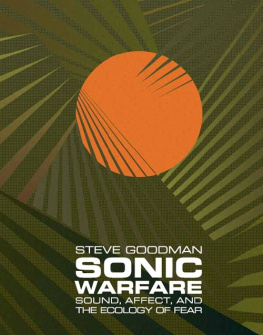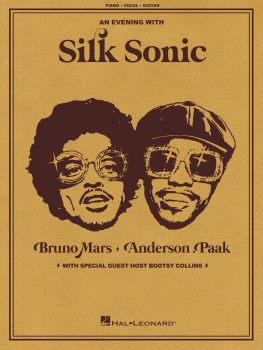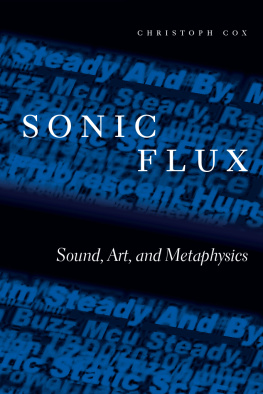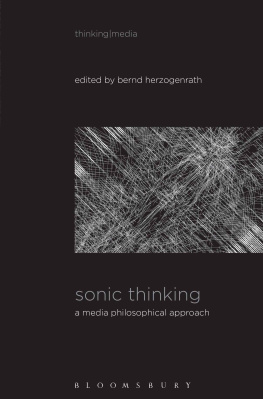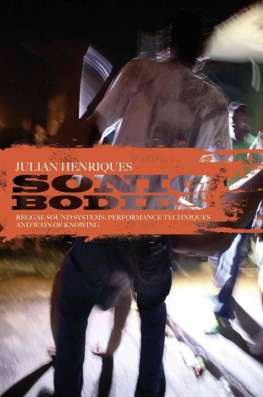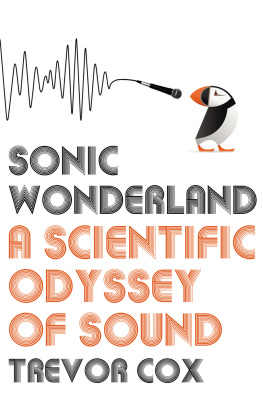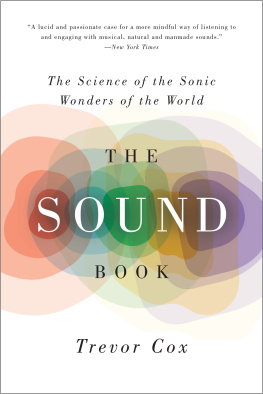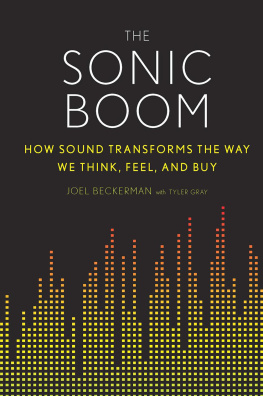
SONIC WARFARE
Technologies of Lived Abstraction
Brian Massumi and Erin Manning, editors
Relationscapes: Movement, Art, Philosophy, Erin Manning, 2009
Without Criteria: Kant, Whitehead, Deleuze, and Aesthetics, Steven Shaviro, 2009
Sonic Warfare: Sound, Affect, and the Ecology of Fear, Steve Goodman, 2010
2010 Massachusetts Institute of Technology
All rights reserved. No part of this book may be reproduced in any form by any electronic or mechanical means (including photocopying, recording, or information storage and retrieval) without permission in writing from the publisher.
For information about special quantity discounts, please e-mail
This book was set in Syntax and Minion by Graphic Composition, Inc.
Printed and bound in the United States of America.
Library of Congress Cataloging-in-Publication Data
Goodman, Steve.
Sonic warfare: sound, affect, and the ecology of fear / Steve Goodman.
p. cm. (Technologies of lived abstraction)
Includes bibliographical references and index.
ISBN 978-0-262-01347-5 (hardcover: alk. paper)
1. MusicAcoustics and physics. 2. MusicSocial aspects. 3. MusicPhilosophy and aesthetics. I. Title.
ML3805.G66 2010
781'.1dc22
10 9 8 7 6 5 4 3 2 1
Contents
Series Foreword
What moves as a body, returns as the movement of thought.
Of subjectivity (in its nascent state)
Of the social (in its mutant state)
Of the environment (at the point it can be reinvented)
A process set up anywhere reverberates everywhere.
The Technologies of Lived Abstraction book series is dedicated to work of transdisciplinary reach, inquiring critically but especially creatively into processes of subjective, social, and ethical-political emergence abroad in the world today. Thought and body, abstract and concrete, local and global, individual and collective: the works presented are not content to rest with the habitual divisions. They explore how these facets come formatively, reverberatively together, if only to form the movement by which they come again to differ.
Possible paradigms are many: autonomization, relation; emergence, complexity, process; individuation, (auto)poiesis; direct perception, embodied perception, perception-as-action; speculative pragmatism, speculative realism, radical empiricism; mediation, virtualization; ecology of practices, media ecology; tech-nicity; micropolitics, biopolitics, ontopower. Yet there will be a common aim: to catch new thought and action dawning, at a creative crossing. Technologies of
Lived Abstraction orients to the creativity at this crossing, in virtue of which life everywhere can be considered germinally aesthetic, and the aesthetic anywhere already political.
Concepts must be experienced. They are lived.
Erin Manning and Brian Massumi
Acknowledgments
A special thanks to Lilian, Bernard, and Michelle for putting up with my noise since day zero.
For the brainpower, thanks to:
Jessica Edwards, Torm, Luciana Parisi, Stephen Gordon, Kodwo Eshun, Anna Greenspan, Nick Land, Mark Fisher, Matt Fuller, Robin Mackay, Kevin Martin, Jeremy Greenspan, Jon Wozencroft, Bill Dolan, Raz Mesinai, Simon Reynolds, Dave Stelfox, Marcus Scott, Mark Pilkington, Erik Davis, Toby Heys, Matt Fuller, Brian Massumi, Erin Manning, Steven Shaviro, Stamatia Portanova, Eleni Ikoniadou, Cecelia Wee, Olaf Arndt, Joy Roles, James Trafford, Jorge Camachio, Tiziana Terranova, Jeremy Gilbert, Tim Lawrence, Haim Bresheeth, Julian Henriques, Jasmin Jodry, Wil Bevan, Mark Lawrence, Neil Joliffe, Sarah Lockhart, Martin Clark, Georgina Cook, Melissa Bradshaw, Marcos Boffa, Dave Quintiliani, Paul Jasen, Cyclic Defrost, Derek Walmsley, Jason and Leon at Transition, Doug Sery at MIT.
For the ideas, collectivity, and bass, maximum respect to:
Ccru, Hyperdub, DMZ, Fwd>>, Rinse, Brainfeeder.
For the sabbatical: The School of Social Sciences, Media and Cultural Studies at University of East London.

Well come in low out of the rising sun and about a mile out, well put on the music.
General Kilgore, Apocalypse Now
Introduction
Its night. Youre asleep, peacefully dreaming. Suddenly the ground begins to tremble. Slowly, the shaking escalates until you are thrown off balance, clinging desperately to any fixture to stay standing. The vibration moves up through your body, constricting your internal organs until it hits your chest and throat, making it impossible to breathe. At exactly the point of suffocation, the floor rips open beneath you, yawning into a gaping dark abyss. Screaming silently, you stumble and fall, skydiving into what looks like a bottomless pit. Then, without warning, your descent is curtailed by a hard surface. At the painful moment of impact, as if in anticipation, you awaken. But there is no relief, because at that precise split second, you experience an intense sound that shocks you to your very core. You look around but see no damage. Jumping out of bed, you run outside. Again you see no damage. What happened? The only thing that is clear is that you wont be able to get back to sleep because you are still resonating with the encounter.
In November 2005, a number of international newspapers reported that the Israeli air force was using sonic booms under the cover of darkness as sound bombs in the Gaza Strip. A sonic boom is the high-volume, deep-frequency effect of low-flying jets traveling faster than the speed of sound. Its victims likened its effect to the wall of air pressure generated by a massive explosion. They reported broken windows, ear pain, nosebleeds, anxiety attacks, sleeplessness, hypertension, and being left shaking inside. Despite complaints from both Palestinians and Israelis, the government protested that sound bombs were preferable to real ones. and the screeching of diving bombers during the blitzkriegs of World War II, the objective was to weaken the morale of a civilian population by creating a climate of fear through a threat that was preferably nonlethal yet possibly as unsettling as an actual attack. Fear induced purely by sound effects, or at least in the undecidability between an actual or sonic attack, is a virtualized fear. The threat becomes autonomous from the need to back it up. And yet the sonically induced fear is no less real. The same dread of an unwanted, possible future is activated, perhaps all the more powerful for its spectral presence. Despite the rhetoric, such deployments do not necessarily attempt to deter enemy action, to ward off an undesirable future, but are as likely to prove provocative, to increase the likelihood of conflict, to precipitate that future.
Sonic Warfare: Sound, Affect, and the Ecology of Fear explores the rippling Shockwaves of these kinds of deployments of sound and their impacts on the way populations feelnot just their individualized, subjective, personal emotions, but more their collective moods or affects. Specifically, a concern will be shown for environments, or ecologies, From vibes to vibrations, this is a definition that traverses mind and body, subject and object, the living and the nonliving. One way or another, it is vibration, after all, that connects every separate entity in the cosmos, organic or nonorganic.
Sonic Warfare outlines the acoustic violence of vibration and the trembling of temperaments. It sketches a map of forces with each step, constructing concepts to investigate the deployment of sound systems in the modulation of affect. The argument is based on the contention that, to date, most theoretical discussions of the resonances of sound and music cultures with relations of power, in their amnesia of vibration, have a missing dimension. This missing dimension, and the ethico-aesthetic paradigm it beckons, will be termed the
Next page
